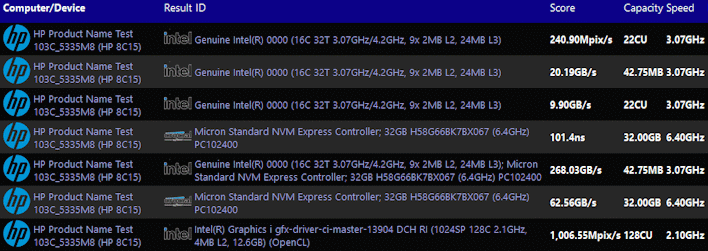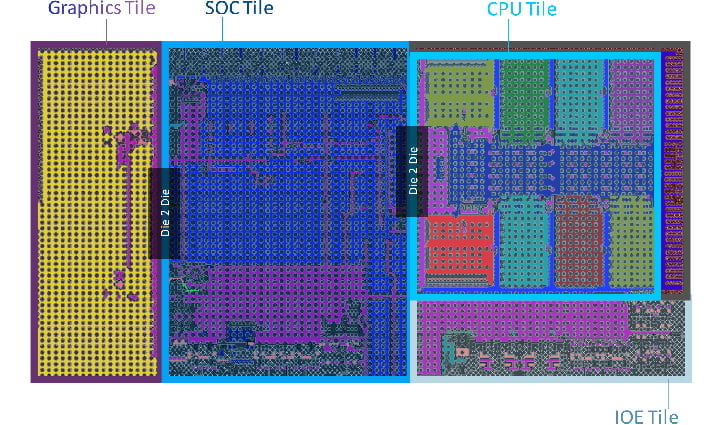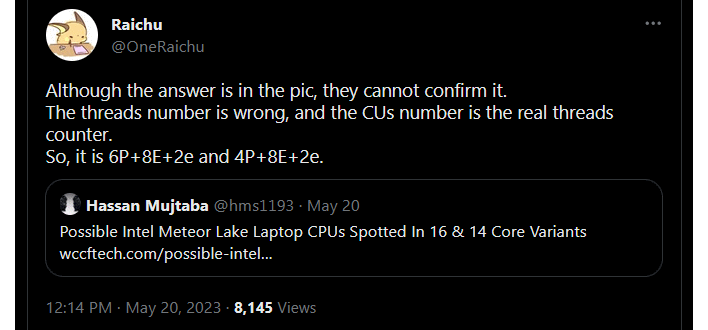Welcome back, friends, to the show that never ends. That's right: it's
dubious hardware leak time, and our subjects today are a pair of what appear to be Intel Meteor Lake CPUs that have popped up in the SiSoft SANDRA result database. We say "appear to be" because the processors have, as usual, been marked out with generic names.
In that case, how do we know they're Meteor Lake? Well, because there aren't any other Intel products that are configured like this. One of the chips is in a
Dell Inspiron 13 5330 laptop platform, and SANDRA puts it down as "14C/28T" CPU, but that's obviously wrong for two reasons. For starters, a 14-core processor wouldn't have seven separate L2 caches, and second of all, the actual core count of the CPU is 18 logical cores.
The only reasonable configuration that matches that number would be a chip with four P-cores, eight E-cores, and then two extra low-power E-cores on the SoC tile. The four P-cores are each a pair of logical cores with their own 2MB L2 cache, and then each quad-core cluster of E-cores gets its own 2MB L2 cache.
The other leaked CPU is in an HP test platform, and that may be why SANDRA reads the system as a desktop
when it probably isn't. This chip has 22 logical cores, which most likely means that it's the same as the other chip with an extra two P-cores (for six, total.) It seems to clock considerably higher than the other model, though: up to 4.2 GHz, according to Sandra.
The most interesting detail about this second chip—and another clue that we're looking at an un-announced Meteor Lake processor—is that it apparently has 128-EU integrated GPU. That sounds a lot like the
Core Ultra processor we saw in the
Ashes of the Singularity database at the beginning of the month, and that CPU had the same 18-logical-core configuration as the first chip we talked about today.
If you're confused about the 4+8+2 or 6+8+2 configurations of these CPUs, we can explain. Intel's 14th-generation CPUs, code-named Meteor Lake, will be its first "disaggregated" client processors. That means they're built using chiplets, or "tiles" to use Intel's nomenclature.
Somewhat similarly to competitor AMD, Intel is breaking out the parts of its processors into separate pieces of silicon, but where AMD uses a simple interposer between the chips, Intel is expected to use another, larger piece of silicon known as a "base tile" to connect everything. Rumor has it that this "base tile" will include a significant L4 cache, itself
apparently code-named "Adamantine."
To get back to the core count discussion, though, these chips will include some allotment of Redwood Cove P-cores and Crestmont E-cores on the primary compute tile. If prior leaks are accurate, the maximum configuration will be 6 P-cores and 8 E-cores. However, there will also apparently be an extra two E-cores on the SoC tile, where the memory controller and other high-speed I/O will likely live.
These two E-cores, being physically removed from the rest of the CPU cores, are not particularly likely to offer great benefits to multi-threading performance—nevermind that they're a pair of puny little E-cores. Instead, they're likely to run at an extremely low clock rate so that they can be used when the system is asleep or otherwise in low-power states. A
previous Intel document called them "LP-E-Cores."
As for when we'll actually get an announcement from Intel about these CPUs,
well, we don't know—but considering that we've already seen a processor labeled
with "Core Ultra" branding, it might be sooner than you think.






